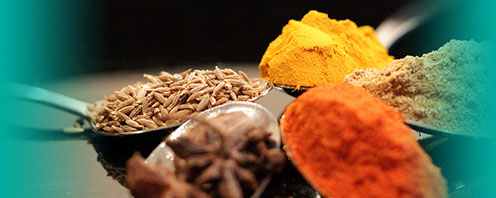

KASHIF´s KITCHEN
History of South Asian Cuisine
Indian food is enjoyed all over the world. The aromatic spices, gravies, curries and special Indian bread - Chapatti and Naan - are favourites among lovers of South Asian cuisine.
Unfortunately, not a lot of people realise there is a very interesting history behind this food,
full of amazing tales and mind blowing facts. My curiosity to know more about this magical cuisine led me to look into its roots and I would like to share my knowledge with you.
When we talk about tantalizing, spicy, exotic Indian food, there is a general impression that we’re talking about modern-day India. This true to some extent, but there are misconceptions, which is why I previously used the term South Asian instead of Indian. To understand this food better, we need to understand the subcontinent.
This is the southern region of Asia, situated mostly on the Indian Plate projecting south into the Indian Ocean, and includes modern-day India, Pakistan, Bangladesh, Sri Lanka, Nepal and Bhutan. The region is more commonly known as South Asia both in Europe and North America and the term is becoming widespread as it clearly distinguishes the region from East Asia (Hong Kong, Japan, North Korea, etc.). Eastern Asia is also famous for its unique cuisine which has similarities with South Asian cuisine, with the same spices but completely different flavours.
Over time, South Asian cuisine has been influenced by a wide variety of foods brought by immigrants and merchants from all over Asia. Merchants reached the subcontinent for the purpose of trade and later settled there for good. Today, when we eat Indian food, it is actually a fusion of cuisine from all over Asia.
Let me take you back to the Indus Valley Civilisation (3300-1300 BCE; mature period 2600-1900 BCE) which extended from what is today northwest Pakistan, to northwest India and northwest Afghanistan. It was one of the three early civilisations of the old World.
I find it amazing that archaeologists have found turmeric, cardamom, black pepper, ginger, garlic, mustard and wheat used by the people of the Indus river valley.
The important thing to note is that this civilisation used three key spices when preparing curry: ginger, garlic and turmeric. That means that Indian curry is not only among the most popular dishes in the world; it is also probably one of the oldest. The Indus Valley Civilization can be considered the pioneers of Indian spices.
Moving on, we enter Vedic times (roughly 1750-500 BCE). The Vedic Civilization was heavily dominated by Hinduism, and later Buddhism; their diet contained dairy products, vegetables, fruits, spices and, to some extent, meat. A huge amount of spices were used in different combinations for various medicines. My grandmother used to say, “you are what you eat” and the Vedic people believed that different types of food had powerful effects on the mind and body.
Ancient Ayurveda treatments list numerous spices for their medical properties: pepper was used to cure digestive ailments; a turmeric paste was applied to burns and itchy skin; ginger was a tried and tested remedy for liver complaints, anaemia, rheumatism and many more complaints. Even today these spices are very commonly used as remedies. Apart from adding colour, flavour and taste, the consumption of Indian spices provided infinite health benefits thanks to their medical properties. This is a vast topic which I will talk more about in my next article.
Now I would like to talk about the arrival of peoples from Arabia, Central Asia, and the Mughal Empire, as well as others who had a fundamental effect on South Asian cooking. The Mughal Empire ruled the subcontinent from the period 1556- 1707. They were Muslims who ruled a country with a large Hindu majority. The Mughals brought many changes to the subcontinent. They created a government with respect for human rights, established Persian art and culture, created the Urdu language (which was a combination of Persian, Arabic and Hindi) and had unique style of architecture. They also introduced an education system that took account of pupils’ needs and was sensitive to their cultural backgrounds. As well as being a period of great religious tolerance, the Mughal period also brought a remarkable change in the subcontinent’s food.
Before the arrival of the Mughals, India’s food was predominantly vegetarian due to the religious beliefs of the majority of Hindus. The Mughal conquest brought with it various types of non-vegetarian food: the famous seekh Kabab, Chicken Tandoori, Tikka botti. The new cuisine also included rich gravies, like Nihari, Haleem, Qorma and lavish dishes like Biryani and pilafas (Pulao).
Mughal Kings were famous for their hospitality and guests at the Shahi Mahals (castles) were treated with great respect and honour and were served lavishly at the Shahi Dastarkhawan (royal dining rooms). Shahi or Mughlai food is also famous for its presentation. Shahi cooks were not only considered to be the best on the subcontinent, but were also famous for their presentation. They served food in extraordinary, expensive, gold carved Thals covered with beautifully embroidered cloth.
The word Shahi means royal, and when you visit Indian and Pakistani restaurants,
the menus often offer Shahi Qorma, or Shahi Kheer, which are actually Mughlai or royal dishes. Indian cuisine is also famous for its desserts like Shahi kheer, Halwas, Methai (sweets),
which were also a Mughlai speciality.
Last but not least, the British and Portuguese were also attracted by the moderate climatic conditions, geographical location and magical atmosphere of this unique land. After the decline of the Mughal dynasty, the British ruled the subcontinent for many years. They further developed the political system, focused on irrigation and created a mind blowing canal system as well as introducing the English language, which is still the constitutional language of India and Pakistan. Inevitably, Indian cuisine was also influenced by the British who added roast meats, trifles, baked goods and tea. Today, India and Pakistan are famous for making a variety of teas (Masala tea, duthpatti, Kashmiri chai, etc.). Indian cuisine also offers tasty cakes and pastries inspired by the British. In 1947, the British withdrew from the subcontinent and it was divided into two independent states - India and Pakistan.
Now you have an idea how the cuisines of these two countries are interrelated. Modern-day Indian cuisines vary widely from region to region and include food from northern, western and southern parts of India, each region having its own speciality and unique ways of cooking. Similarly, Pakistani cuisine also varies greatly from region to region. Food from eastern Punjab and Sind are similar and can be highly seasoned and spicy; food in the northern part of Pakistan have distinct tastes based on various regional influences. Pakistani cuisine, therefore, is the descendent of Indo-Aryan culture and Muslim culinary traditions.
I hope this article has given you a clearer picture of what Indian and Pakistani cuisine is all about. Both use similar spices, similar styles of cooking, share a common cooking history and, although both countries have their own unique taste influenced by their regional, cultural and climatic situations, it is very difficult to distinguish between the two. However, there is a big difference when we talk about Masla Dosa, a south Indian dish from Kerela, and Chapli Kabab from Peshawar in northern Pakistan.
I would say Indian or Pakistani cuisine - Food that brings smiles!
